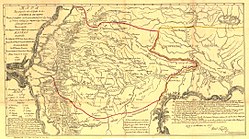| Real Audiencia of Quito Real Audiencia de Quito | |||||||||
|---|---|---|---|---|---|---|---|---|---|
| Real Audiencia of the Viceroyalty of Nueva Granada | |||||||||
| 1563–1822 | |||||||||
 Royal Audiencia of Quito, a map of 1779 by Francisco Requena y Herrera | |||||||||
| Capital | Quito | ||||||||
| Area | |||||||||
| • Coordinates | 0°15′S78°35′W / 0.250°S 78.583°W | ||||||||
| • Type | Audiencia Real | ||||||||
| Historical era | Spanish Empire | ||||||||
• Established | 29 August 1563 | ||||||||
• Incorporation into Colombia | 24 May 1822 | ||||||||
• Independence of Ecuador | 13 May 1830 | ||||||||
| |||||||||
| Today part of | Ecuador, Colombia, Peru, Brazil | ||||||||

The Real Audiencia of Quito (sometimes referred to as la Presidencia de Quito or el Reino de Quito) was an administrative unit in the Spanish Empire which had political, military, and religious jurisdiction over territories that today include Ecuador, parts of northern Peru, parts of southern Colombia and parts of northern Brazil. It was created by Royal Decree on 29 August 1563 by Philip II of Spain in the city of Guadalajara. [1] [2] It ended in 1822 with the incorporation of the area into the Republic of Gran Colombia.

